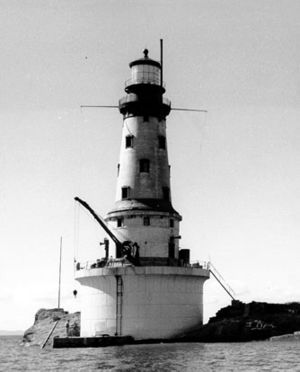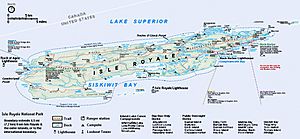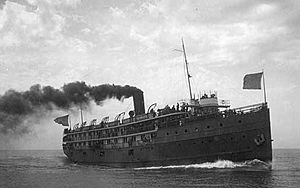Rock of Ages Light facts for kids
 |
|
| Undated United States Coast Guard photo | |
|
|
|
| Location | Isle Royale, Michigan |
|---|---|
| Coordinates | 47°52′00″N 89°18′48″W / 47.86667°N 89.31333°W |
| Year first constructed | 1908 |
| Year first lit | 1910 |
| Automated | 1978 |
| Foundation | Concrete Pier Steel Caisson |
| Construction | Steel, Masonry, Concrete |
| Tower shape | Cylindrical base/Frustum of a Cone tower |
| Markings / pattern | White Black base and lantern |
| Height | 117 feet (36 m) |
| Focal height | 130 feet (40 m) |
| Original lens | 2nd Order bivalve Fresnel Lens |
| Current lens | 12-inch (300 mm) Tideland Signal ML-300 Acrylic Optic |
| Range | 15 nautical miles; 27 kilometres (17 mi) |
| Characteristic | two flashes every 10 s |
| ARLHS number | USA-698 |
| USCG number | 7-16655 |
The Rock of Ages Light is a tall lighthouse on a small rock near Isle Royale National Park in Michigan. It helps ships navigate safely on Lake Superior. This lighthouse is still active today, guiding boats away from dangerous rocks. It stands on a rock about 50 by 200 feet wide. The lighthouse is about 2.25 miles west of Washington Island. It is also 3.5 miles west of Isle Royale.
Contents
History of the Lighthouse

Why Lighthouses Were Built
For many years, especially from 1852 to the early 1900s, there was a lot of work to build lighthouses on the Great Lakes. The United States Lighthouse Board was very busy. Between 1852 and 1860, 26 new lighthouses were built. Even during and after the American Civil War, 12 new lights were still lit. In the 1870s, 43 more new lights were added. The 1880s saw over 100 new lighthouses constructed.
By the early 1900s, the Lighthouse Board managed many aids to navigation. This included 334 main lights, 67 fog horns, and 563 buoys.
Over time, lighthouse designs changed. Before 1870, lighthouses often had the light on the roof of the keeper's home. Or, they had a small square tower attached to the house. In the 1870s, taller, round brick towers were built. These were usually 80 to 100 feet tall. This helped the light shine from a higher point. By the 1890s, new towers made of steel started to replace the older brick ones.
The Rock of Ages Light was part of a big project that lasted 40 years. From 1870 to 1910, engineers started building lighthouses on isolated islands, reefs, and shoals. These spots were very dangerous for ships. Before this, Light ships were used to mark these hazards. But lightships were risky for sailors and hard to keep working. They could also be pushed off course in bad storms. This made them unreliable when captains needed them most.
Engineers learned to build strong lighthouses in the water. They used special underwater foundations called cribs. Famous examples include the Waugoshance Light (1851) and the Spectacle Reef Light (1874). Other impressive lights were the Stannard Rock Light (1882) and the Detroit River Light (1885). The Rock of Ages (1908) and the White Shoal (1910) lights were among the last of these big projects.
In the early 1900s, more lighthouses were built on the Great Lakes. By 1925, most of the lighthouses we see today were already standing. At that time, 160 stations still had keepers. Many other navigation aids were automated, meaning they worked by themselves.
Shipwrecks Before the Lighthouse
The Rock of Ages reef is a group of rocks west of Isle Royale. These rocks were a big danger to ships. Several ships crashed on this reef before the lighthouse was built.
The Cumberland was a 200-foot-long steamer. It was built in Canada in 1872. In July 1877, it hit the reef in clear weather. People tried to pull the ship off the rocks, but they failed. The ship was left behind on August 6, 1877. Later that month, it broke in half and sank nearby.
On October 18, 1898, the Henry Chisholm also ran onto the rocks. This ship was built in Cleveland, Ohio in 1880. It was moving at 9 knots (about 10 miles per hour). Rescue boats could not save it. A storm at the end of October broke it apart. It sank right on top of the Cumberland wreck.
Building the Rock of Ages Light
Construction on the Rock of Ages lighthouse began in 1908. Workers set up a base at Washington Harbor. They used a special boat called the Amaranth to bring men and materials to the site. First, they blasted a section of rock to make a flat area for the foundation. Then, they built a steel wall in a circle. This wall was filled with concrete to create a pier 50 feet wide and 25 feet tall.
The tower's frame was built from steel. The inside and outside walls of the tower were made of brick. Concrete floors were supported by steel beams. The spiral stairs were made of cast iron. Once the tower was enclosed, a bunkhouse, dining hall, and kitchen were built on a wooden platform on the rock. The lighthouse first shone with a temporary light in 1908.
In 1910, a special Fresnel lens was installed. This lens was made by Barbier, Benard & Turenne. It floated in a pool of mercury, which made it turn very smoothly. These huge lenses are 81.46 inches tall and weigh 3,530 pounds. This type of lens was much brighter than older ones. It could shine its light up to 20 nautical miles away.
A team of keepers lived at the station during the shipping season. They would arrive in spring and leave in the fall. Because the light was so far away and hard to reach, getting supplies was very difficult and risky. One time, the crew ran out of food and only had one can of tomatoes left before they were rescued. After that, the lighthouse service made sure this would not happen again.
The Rock of Ages lighthouse has a unique design. Its base, called a caisson, is 25 feet high and has a two-story basement. A strong steel core runs through the middle of the structure from the bedrock up. This core is the main support for the entire lighthouse.
The Rock Harbor Light station closed partly because the Isle Royale Light was built in 1875. Later, a third lighthouse, the Passage Island Light, was lit in the Isle Royale area in 1882.
The Rock of Ages Light became automated in 1978. This meant that lighthouse keepers were no longer needed after 68 years of service. In 1985, the original Fresnel lens was replaced when the light started using solar power.
The original Fresnel Lens is now on display at the Windigo Information Station. Many people say seeing the lens is "worth the trip."
The Wreck of the George M. Cox
The George M. Cox was a 270-foot-long steamer. It was built in 1901 and first named the SS Puritan. This ship briefly served in the United States Navy after World War I. It helped bring troops home. In 1933, George Cox bought the ship and renamed it the George M. Cox.
On May 27, 1933, the Cox was cruising on Lake Superior with special guests. The captain and first mate heard the foghorn from the Rock of Ages Light. But they kept going at full speed (16.5 knots or about 19 miles per hour). This was against the rules for limited visibility. The Cox hit the reef in heavy fog near the lighthouse.
The ship got stuck in the middle, with its front pointing up and its back filling with water. The crew safely got off the ship using five lifeboats and several life rafts. John Soldenski, the Rock of Ages lighthouse keeper, quickly went to help. He used his gasoline-powered boat to tow the life rafts back to the lighthouse. The lifeboats followed behind. The 127 passengers and crew spent the night crowded in the lighthouse and on the nearby rocks. The ship could not be saved. It stayed on the rocks until a storm in October broke it apart. It sank near the wrecks of the Cumberland and the Chisholm.
National Register of Historic Places
The Rock of Ages Light Station was added to the National Register of Historic Places on August 4, 1983. This means it is a historically important place. It was also studied by the Historic American Buildings Survey. This is because it was a "major engineering feat in an isolated location."
The wrecks of the Cumberland, the Chisholm, and the George M. Cox were also added to the National Register of Historic Places separately.
Viewing the Light
The lighthouse tower has many weather instruments. It is a NOAA C-MAN station. This means you can find real-time weather information from the lighthouse online [1].
The tower itself is closed to visitors. You can only reach it by boat. However, you can see it from ferries that go to Isle Royale from Grand Portage, Minnesota. You can also see it from boat tours offered by Keweenaw Excursions. The Grand Portage Isle Royale Transportation Line has two boats that go to Isle Royale National Park. The Sea Hunter III travels daily to Windigo, on the west end of Isle Royale. The Voyageur II makes overnight trips. The lighthouse is visible from both boats during the summer.
Restoration Efforts
The Rock of Ages Lighthouse Preservation Society started restoring the lighthouse in 2014. They are working with the National Park Service. The Society plans to open the lighthouse to the public once the restoration is finished.





